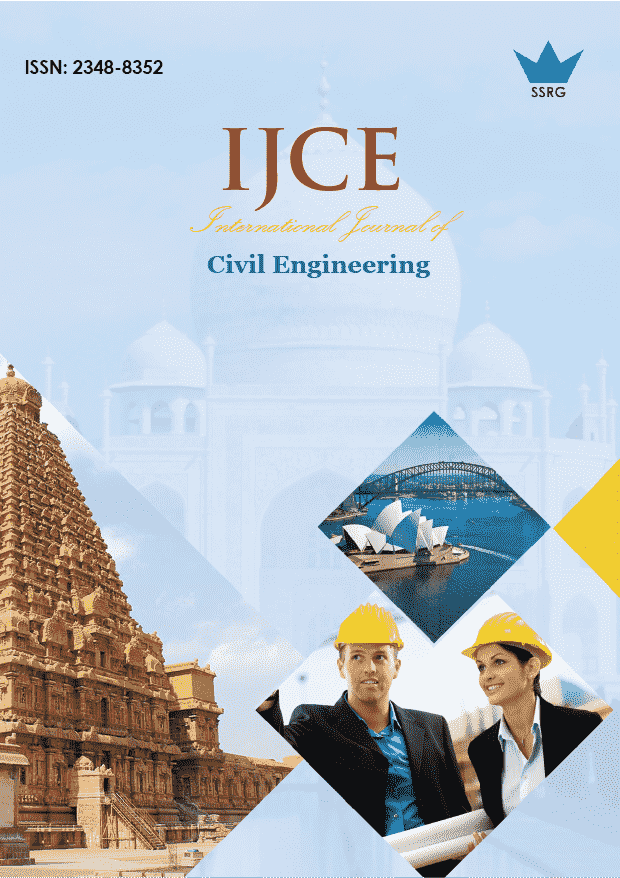Determinants of Walking as a Mode of Transportation: A Case Study of Howrah

| International Journal of Civil Engineering |
| © 2025 by SSRG - IJCE Journal |
| Volume 12 Issue 3 |
| Year of Publication : 2025 |
| Authors : Sharif Hossain, Anuj Kishor Budhkar, Protik Saha Palash, Rahul Kumar Bharti |
How to Cite?
Sharif Hossain, Anuj Kishor Budhkar, Protik Saha Palash, Rahul Kumar Bharti, "Determinants of Walking as a Mode of Transportation: A Case Study of Howrah," SSRG International Journal of Civil Engineering, vol. 12, no. 3, pp. 185-190, 2025. Crossref, https://doi.org/10.14445/23488352/IJCE-V12I3P117
Abstract:
This study investigates the factors influencing the choice to walk for work trips in Howrah, a densely populated city characterized by narrow streets and by-lanes. A sample of 250 residents from 25 wards were surveyed to analyze socio-demographic and trip-specific variables, including age, education, house rent, and trip length. The study addresses two main questions: whether residents prefer walking for work trips and the reasons behind this choice, such as budget, health, short distance, or a lack of preference. Logistic regression analysis revealed that age, education, house rent, and trip length significantly impact walking preferences. Wealthier individuals were found less likely to walk due to insufficient pedestrian infrastructure, while older individuals walked more for health and budget reasons. The study highlights the urgent need for better pedestrian infrastructure, including safer footpaths and pedestrian-friendly streets, especially for older residents. This research fills a critical gap in urban transportation studies by exploring walking behavior in the Indian context, offering valuable insights for planners aiming to improve urban mobility.
Keywords:
Pedestrian mobility, Resilient infrastructure, Sustainable development, Road safety, Traffic management.
References:
[1] Anu Plavara Alex et al., “Latent Variable Enriched Mode Choice Model for Work Activity in Multi Modal Condition Prevalent in India,” International Journal of Traffic and Transportation Engineering, vol. 6, no. 4, pp. 378-389, 2016.
[CrossRef] [Google Scholar] [Publisher Link]
[2] Dustin T. Duncan et al., “Walk Score, Transportation Mode Choice, and Walking Among French Adults: A GPS, Accelerometer, and Mobility Survey Study,” International Journal of Environmental Research and Public Health, vol. 13, no. 6, pp. 1-14, 2016.
[CrossRef] [Google Scholar] [Publisher Link]
[3] Yaser Hatamzadeh, Meeghat Habibian, and Ali Khodaii, “Effective Factors in Walking Mode Choice of Different Age Groups for School Trips,” Transportation Research Procedia, vol. 25, pp. 2297-2308, 2017.
[CrossRef] [Google Scholar] [Publisher Link]
[4] Arnab Jana, and Varun Varghese, “Analyzing Mode Choice for Inter-Regional Travel in India,” Transportation Research Procedia, vol. 25, pp. 5220-5234, 2017.
[CrossRef] [Google Scholar] [Publisher Link]
[5] V.L. Kokate et al., “E-Rickshaw Present Past and Future with Reference to Current Transportation in India,” International Conference on Recent Innovations in Electrical, Electronics & Communication Engineering, Bhubaneswar, India, 2019.
[Google Scholar]
[6] Najeebul Feroz Malik et al., “An Analysis of Mode Choice Decisions for Long-Distance Recreational Travel in India,” Transportation in Developing Economies, vol. 10, no. 2, 2024.
[CrossRef] [Google Scholar] [Publisher Link]
[7] Janak Parmar, Gulnazbanu Saiyed, and Sanjaykumar Dave, “Analysis of Taste Heterogeneity in Commuters’ Travel Decisions Using Joint Parking-and Mode-Choice Model: A Case from Urban India,” Transportation Research Part A: Policy and Practice, vol. 170, pp. 1-36, 2023.
[CrossRef] [Google Scholar] [Publisher Link]
[8] Gopal R. Patil, Rounaq Basu, and Taha H. Rashidi, “Mode Choice Modeling using Adaptive Data Collection for Different Trip Purposes in Mumbai Metropolitan Region,” Transportation in Developing Economies, vol. 6, pp. 1-10, 2020.
[CrossRef] [Google Scholar] [Publisher Link]
[9] Arindam Roy, “E-Rickshaw Service in Barddhaman Town: Importance, Problems and Future Prospects,” International Journal of Scientific and Research Publications, vol. 6, no. 9, pp. 702-706, 2016.
[Google Scholar] [Publisher Link]
[10] Feng Shi et al., “Optimization Method of Alternate Traffic Restriction Scheme Based on Elastic Demand and Mode Choice Behavior,” Transportation Research Part C: Emerging Technologies, vol. 39, pp. 36-52, 2014.
[CrossRef] [Google Scholar] [Publisher Link]
[11] Danique Ton et al., “Cycling or Walking? Determinants of Mode Choice in the Netherlands,” Transportation Research Part A: Policy and Practice, vol. 123, pp. 7-23, 2019.
[CrossRef] [Google Scholar] [Publisher Link]
[12] Marcus Wigan, “Treatment of Walking as a Mode of Transportation,” Transportation Research Record, pp. 7-13, 1995.
[Google Scholar]
[13] Meghan Winters, Ralph Buehler, and Thomas Götschi, “Policies to Promote Active Travel: Evidence from Reviews of the Literature,” Current Environmental Health Reports, vol. 4, pp. 278-285, 2017.
[CrossRef] [Google Scholar] [Publisher Link]

 10.14445/23488352/IJCE-V12I3P117
10.14445/23488352/IJCE-V12I3P117